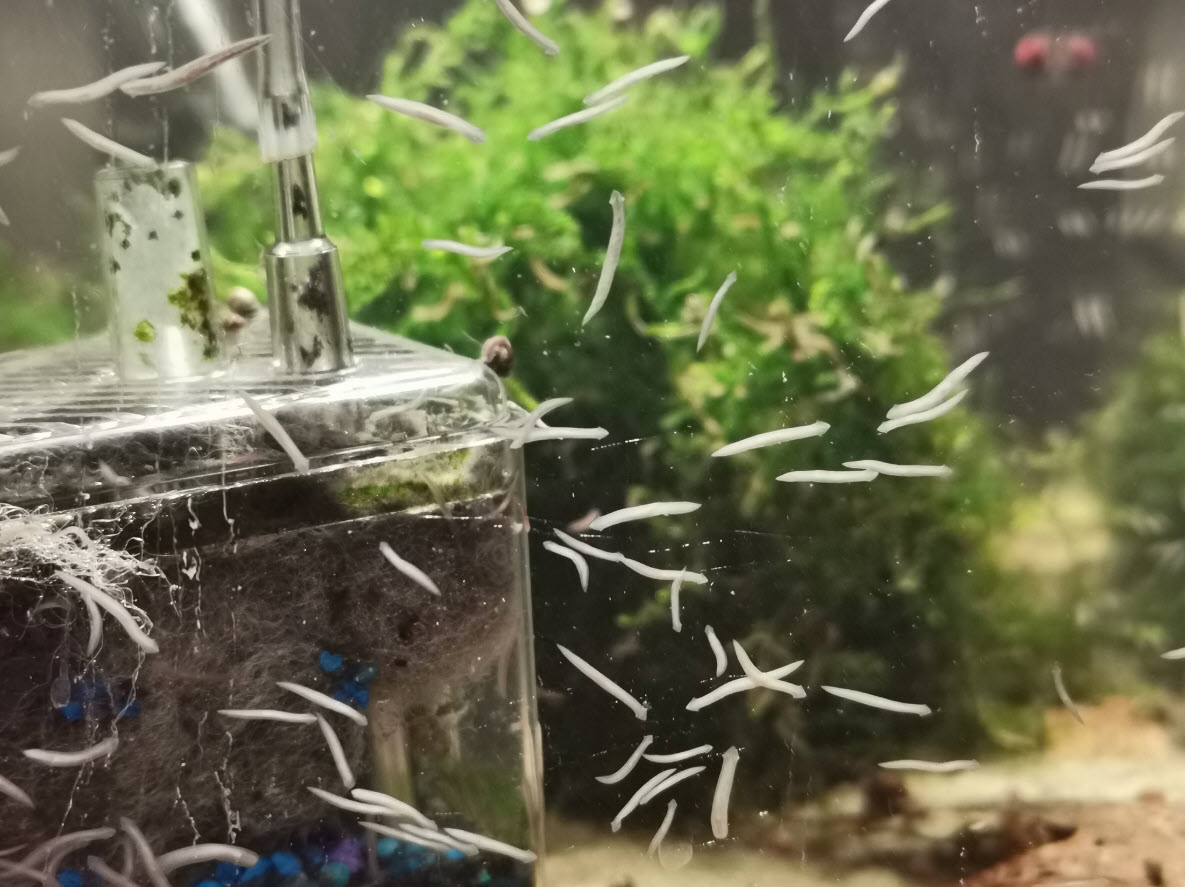
Planaria are a type of flatworm or Platyhelminth. Other flatworms are flukes and tapeworms. Flatworms are very primitive organisms.
All flatworms have relatively wide very flat bodies. They look like earthworms which have been flattened by a rolling pin. They just kind-of magically glide on a film of mucous. They do not swim free in the aquarium water like detritus worms. They do not move like snakes or earthworms. They move will cilia on their mucous surface, like snails. Because they move with cilia they cannot move any faster than a snail, which is notoriously slow. There are many who look at rapidly expanding and contracting brown leeches and mistake them for planaria. Planaria do NOT expand and contract nor do they move even moderately fast.
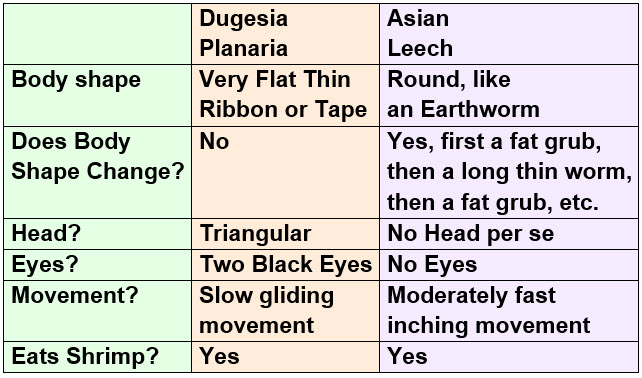
There are two types of flatworms found in aquariums. Planaria have a distinct triangular head and two tiny black eyes and can get up to half an inch in size and be a real problem in shrimp tanks or in tanks with fish fry. A close relative, rhabdocoelas, has a round head, typically is quite small and is never a problem. They are both common in small numbers in aquariums.
Planaria Flatworms
Most aquariums have a few planaria of one species or another in them, generally introduced with plants. Planaria have triangular heads and two black eyes on the head.
There are two general types of planaria seen in aquariums, brown planaria (Dugesia) and white planaria (Procotyla). Some Dugesia planaria species are over an inch long. Planaria are strictly carnivores, eating small worms, crustaceans, snails and fish fry. Many species have poisonous secretions which paralyze prey. This allows them to eat prey much larger than they are.
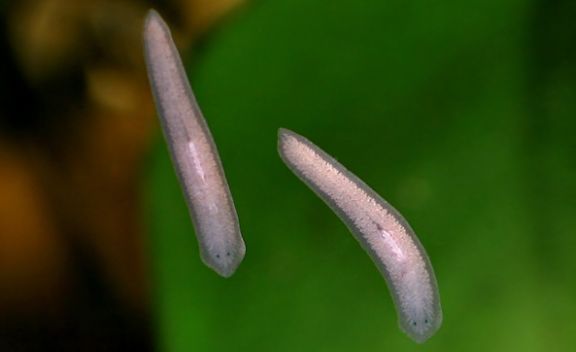
.
Planaria exude a substance that stuns and paralyzes arthropods like shrimp. The planaria will then eat the shrimp while it is alive. A small planaria can stun and kill shrimp much larger than themselves. Planaria are used to control another arthropod, namely mosquitos, so they do a good job of attacking small arthropods. Planaria can also attack fish larvae, fry and eggs.
There are always comments on social media along the lines of “I’ve got both planaria and shrimp and have no problem“. There are hundreds of species of planaria and only some of them attack shrimp. So the social media comments can be correct. But there are several YouTube videos of planaria paralyzing and eating shrimp in the aquarium. There is also one video of planaria which are enveloping and eating very small fish larvae (fish larvae are the immobile eyeless babies that have a large yoke sack still attached). Dugesia are always a problem in a shrimp tank. Some species of white planaria are harmless.
Because planaria typically only come out at night it is common to have a shrimp tank with planaria where the shrimp are just mysteriously not successfully reproducing. I recommend prophylactic treatment with fenbendazole, praziquantel or No-planaria of anything which goes into a shrimp tank.
Note that many hobbyists have come on social media with videos of what they describe as planaria when what they actually have is Asian leeches. Planaria do not swim free in the aquarium. Leeches do swim free and leeches can travel rapidly much like earthworms (like earthworms, leeches are tubeworms or annelidan worms). Leeches have a round body shape and move in a sometimes rapid inching movement. Planaria are very flat (i.e. “flatworms”) and travel much like snails, in a slow gliding motion on a film of mucous.
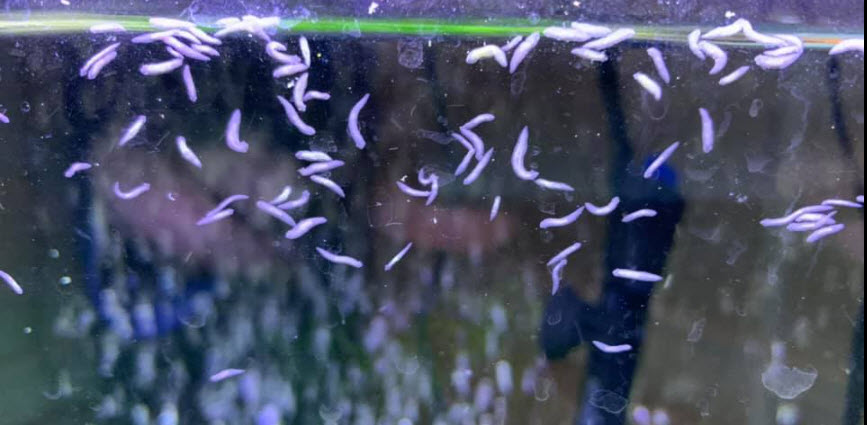
Treating Planaria
There are many options for treating planaria. Praziquantel is the preferred treatment in shrimp tanks. Fenbendazole kills the planaria better than praziquantel but is deadly to some snails and some sensitive shrimp species. No-planaria is the extract of a betel nut and kills only planaria. Copper will kill all non vertebrates (i.e. planaria, snails and shrimp) at the same strength as used for treating ich.

Any medication needs to be administered seven times spaced one week apart to eliminate planaria. The planaria eggs can take up to 48 days to hatch.
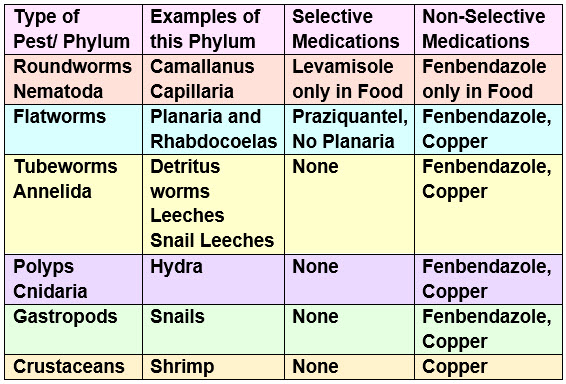
Note that the cautions about deaths of snails, shrimp and invertebrates is very dose dependent. Copper and Fenbendazole are often used with no snail deaths because the dosage isn’t high enough. Conversely using a very high dosage of fenbendazole can possibly kill shrimp. But copper WILL kill shrimp at any reasonable dosage. Praziquantel is safe with everything except planaria and flukes and is the treatment of choice in tanks with snails or shrimp.
The dosages for fenbendazole and praziquantel are as follows:

One treatment is traps. These can be purchased or made from API test tubes and airline. They are effective at controlling planaria but cannot eliminate planaria from a tank:
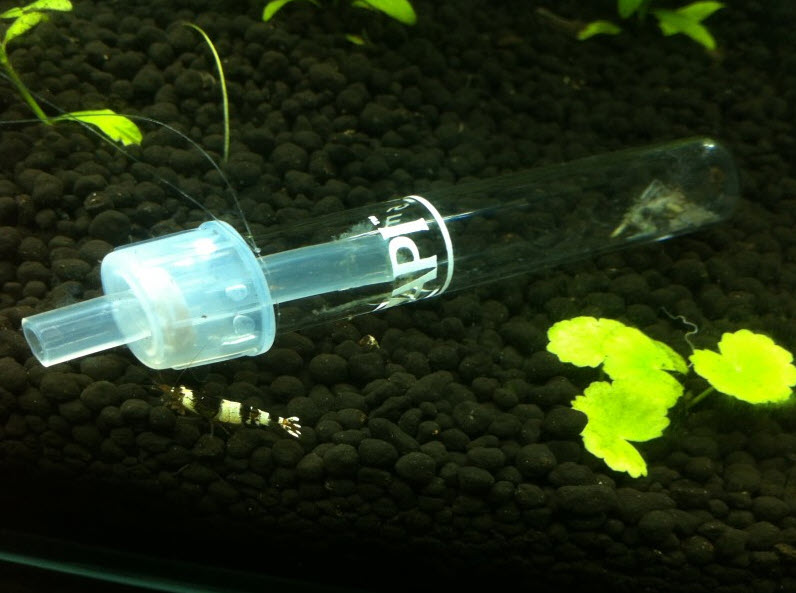
.
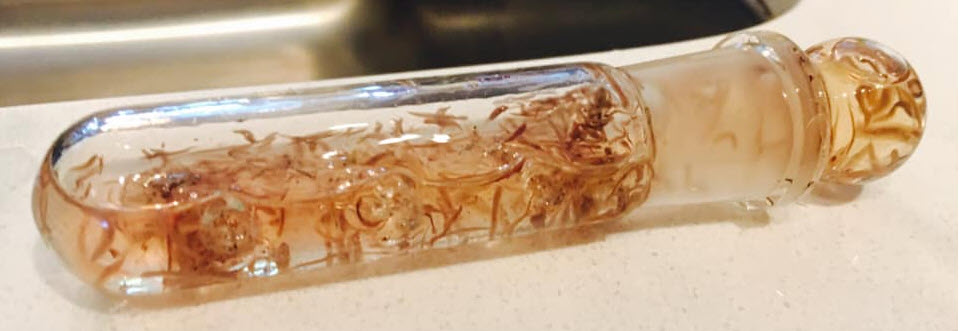
Note that there are many websites which recommend a host of products to treat planaria in shrimp tanks. These recommendations have blue underlined links to the products, typically an Amazon website. If you click on these links and buy the product, the website receives a commission.
If you found the website through a search engine like Google, the search engine receives a commission. Isn’t the profit motive wonderful? How accurate do you think the recommendations of such websites are? For that matter, how accurate do you think a search engine search is?
Rhabdocoelas
A relatively common denizen of aquariums is Rhabdocoelas, a close relative of planaria. They are like planaria without the points on the head. There are many species, typically white or translucent. Sometimes they are so translucent they are difficult to see. They are all completely harmless.

Occasionally large populations of small white rhabdocoelas congregate on the glass of the aquarium just above the waterline, freaking out the hobbyist. Sometimes fifty or more translucent small rhabdocoelas will be seen gliding around on the glass of an aquarium. They can be so transparent that they don’t show up if a video is taken of them.

For more information on all the various pests found in the aquarium click on the following link:
10.13. Pests in the Aquarium
.
Return to Diseases Menu
.
Aquarium Science Website
The chapters shown below or on the right side in maroon lead to close to 400 articles on all aspects of keeping a freshwater aquarium. These articles have NO links to profit making sites and are thus unbiased in their recommendations, unlike all the for-profit sites you will find with Google. Bookmark and browse!
.

Dave says
In reply to Cayden …… probably enters their bodies as they glide over the substrate.
Cayden says
Hi Dave,
You said Fenbendazole or Praziquantel can be used to treat planaria. Both of those are insoluble in water. So how do they kill planaria? Do planaria eat the powder, or does it enter their bodies when they glide over it on the substrate?
Thanks in advance.
Neo says
Hi,
Just want to make sure that the use of Praziquantel is safe to use in a tank with neocaridina shrimps and trumpet snails?
Jessica Gazon says
Sadly, rhabdacoelas are not harmless to snail eggs and baby snails.
Tracy says
Thank you so much! This answered all my questions❤️
Mark B says
Hi Dave, I hope all is well with you and your health.
Question on the “dosages for fenbendazole and praziquantel” chart above, in this chapter. (10.13.3 Planaria) I’d just like to double-check that the “grams per 10 gallons product” dosage for fenbedazole (Panacur C) is correct at “0.68 grams” as shown. What gives me pause is this: If the “cost per gram of product” is $2, and we’re using less than 1 gram of the product, how can the “cost to treat 10 gallons” be $6.12? My apologies in advance if I’ve missed something.
Thanks, Mark B
Sarah says
Why are they so cute tho?